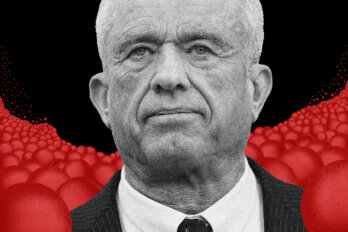Marco Zenone is a public health researcher who studies misinformation and online portrayals of health and wellness issues. A few years ago, he wanted to study the usefulness and accuracy of mental health TikTok videos. When he asked whether I’d be interested in joining his team, I didn’t hesitate.
We took a sample of the top 1,000 TikTok videos with the hashtag #mentalhealth from a specific time frame in 2021 and then analyzed the content. Most videos involved users sharing their personal stories, thoughts, or perspectives, and over one-third contained advice or information presented as factual. When we analyzed the videos with advice and information—which were watched over 1 billion times—we found that 67 percent could be considered useful but 33 percent were misleading. Some of the misleading ones parroted anti-psychiatry tropes, such as the idea that medications aren’t helpful and “are for profit only.” Alarmingly, the misleading videos also received more views, likes, comments, and shares than the ones we classified as useful. Our findings are consistent with other studies showing that TikTok videos contain high amounts of misinformation about more specific health topics, such as attention-deficit hyperactivity disorder, diabetes, prostate cancer, and COVID-19.
TikTok is only one gargantuan source of mental health misinformation where online creators can—unintentionally or not—play expert and therapist to billions of users. We are at a point in human history where we have access to the best available information at our fingertips, and yet it doesn’t lead to better-informed health decisions, because that information is drowned out by a rival proliferation of emotionally charged fake science news, conspiracies, alternative facts, and social media echo chambers.
The so-called father of the wellness movement, biostatistician Halbert L. Dunn, first used the term in Canadian Journal of Public Health in 1959. Dunn distinguished between good health—freedom from illness—and high-level wellness, defined as “an integrated method of functioning which is oriented toward maximizing the potential of which the individual is capable, within the environment where he is functioning.” Dunn’s thoughtful definition didn’t stick. “Wellness” quickly took on a life of its own.
In many parts of North America, wellness has now sprouted on every corner. Across from your local Starbucks, you’ll see yoga and meditation classes interspersed with spa, weight loss, massage, acupuncture, and chiropractic clinics. Employee wellness programs offering subsidized gym memberships for work-life balance and mental health are a click away.
In her book The Gospel of Wellness: Gyms, Gurus, and the False Promise of Self-Care, journalist Rina Raphael laments how there’s no agreed-upon definition of wellness, noting that it’s one reason the industry has grown so big. “Wellness has devolved into an ambiguous marketing term that can just as easily mean activated charcoal toothpaste as it does mindfulness.” It has seemingly ballooned to include anything and everything. Ask one guru what they mean by wellness and receive a different answer from the next. The term has drifted from Dunn’s definition and morphed into dollar signs, drawing us into a never-ending cycle of enhancing our health by treating problems we didn’t know we had.
The wellness industry is currently valued at a breathtaking $5.6 trillion (US) worldwide, which includes earnings from bona fide resources for healthier living (e.g., sports and exercise classes) as well as alternative medicine products and services. It also includes what’s been dubbed the $181 billion (US) global mental wellness economy, to capture money spent on sleep services and monitors, meditation and mindfulness resources, supplements for “brain health,” cannabis and psychedelics, and self-help delivered by gurus, coaches, organizations, and apps.
Most perniciously, wellness has come to represent a wonderland free from the constraints of scientific scrutiny. The beating heart of the industry flows with pseudoscience, and to say that it’s lucrative would be an understatement. It’s the commercial home to the alternative medicine industry itself, estimated to be worth nearly $200 billion (US) worldwide in 2025. In the United States alone, Americans spend over $30 billion per year on alternative medicine, and even the homeopathy industry is valued at $1.2 billion, used by an estimated 5 million adults and 1 million children.
As I’ve studied alternative medicine and its advertising in the mental health realm, I’ve found that it’s as sly and adaptable as some of the charismatic grifters who read from its script. To be fair, not all promoters of alternative medicine are aware of what they’re parroting. But repeat a lie often enough and it becomes your truth. Commodified alternative medicine is an ideology. It’s not merely a set of unsupported and pseudoscientific health practices that prosper at the borders of evidence-based health care.
Baked into alternative medicine are moralizing attitudes handed down from the early evolution of the wellness industry. It has its own tropes to propagate distrust in mainstream health care—and its own fallacies to cajole audiences. It also shape-shifts in its name to sneak pseudoscience into the health care system at large.
Historically, alternative medicine has been called drugless healing, fringe medicine, holistic medicine, irregular medicine, and medical cultism. The term “alternative medicine” began to be used in the 1970s. And according to medical historian James C. Whorton, it’s loaded. The word “alternative” juxtaposed with “medicine” suggests that alternative medicine competes with mainstream medicine while simultaneously connoting a modicum of “medicine’s” legitimacy. It implies somewhat of a false balance in two approaches to health regardless of what the science has to say.
The rhetorical trickery continued as time went on. In the 1990s, the acronym “CAM” was coined to represent the term “complementary and alternative medicine.” In this sleight of hand, adding the word “complementary” conferred more legitimacy to alternative medicine by subtly transforming its image from a fishy, backup option to one that could be used alongside mainstream medicine. Shortly after, the term “integrative medicine” emerged, pioneered by Andrew Weil, a Harvard-trained physician and bestselling author, even further suggesting that alternative medicine could be “integrated” into the mainstream health care system. And then came “functional medicine,” a deceitfully vague term invented by professor Jeffrey Bland to sell dietary supplements.
The use of evolving, deceptive language in alternative medicine is also reflected in the branch of the US government devoted to exploring its merit. The Office of Alternative Medicine was first established in 1991. It then became the National Center for Complementary and Alternative Medicine in 1998. When it transformed to its latest flavour, in 2014, as the National Center for Complementary and Integrative Health, dropping the word “alternative,” it was criticized for attempting continually to dodge the fact that it repeatedly and unethically funds scientifically implausible studies, such as investigating the effect of distant prayer in the treatment of AIDS and energy healing in the treatment of prostate cancer.
When I use social media to teach the perils of pseudoscience, one thing I notice is that many people are rightly confused about alternative medicine terminology. For example, when I explain that integrative medicine is just a fancy disguise for alternative medicine, people often ask me, “But isn’t integrative care a good thing?” They’re understandably perplexed about the word “integrative,” because it’s also used in health care settings to describe evidence-based collaboration on multidisciplinary teams among professionals. That kind of care isn’t integrative medicine, but it’s no accident that it sounds like it is.
Alternative medicine is a con game. Its various iterations—CAM, integrative medicine, and functional medicine—are marketing terms designed to confuse patients, promote pseudoscience, and sow distrust in mainstream medicine. And when these labels no longer serve as an adequate cover-up for pseudoscience, alternative medicine will be forced to rebrand once again.
It’s undeniable that America has a gun violence problem. On December 14, 2012, Adam Lanza died by suicide after murdering twenty students and six staff members at Sandy Hook Elementary School. To add to the agony of an already despairing community, numerous conspiracy theories surfaced doubting what had transpired. The most popular one disputed that the massacre even occurred, with claims that it was an elaborately orchestrated hoax by the political left to advocate for stricter gun control. It was broadcast by Alex Jones, a radio host for The Alex Jones Show and infamous conspiracy theorist. Parents of the children who died have been suing Jones and his company for several years, leading him to file for bankruptcy and owe billions of dollars in damages—but it hasn’t been enough to shut down his operation.
When I went to Jones’s website, Infowars, I was immediately accosted by an advertisement: “Amp up your body’s probiotic potential with prebiotic fiber—Back in Stock 40% off—Shop Now.” Then I clicked on his Infowars Store and the “Health & Wellness” section, which took me to virtual shelves of more dietary supplements: “Better Mood + ” for $59.99; “Mushroom Max Nootropic” for $59.99; “CBD Full Spectrum 1000 mg” for $89.99; “Immune Support” for $29.95; there was even an “Alex Jones Was Right—Fundraiser Shirt” for $24.95 (prices in US dollars).
What is going on here? Why would a far-right conspiracy theorist be peddling wellness products that allege to provide “mood balance” and support your immune system “naturally with ultra-high qualities selected for their nature-based benefits”?
According to New York Times journalist Farhad Manjoo, stoking conspiracy theories is just a marketing tool for Jones—one that attracts people to his website and bombards them with ads for snake oil. It’s what allowed Jones to generate an average of $55 million (US) in annual revenue from 2016 to 2019.
Jones is not alone in marrying wellness with conspiracies. In 2009, the term “conspirituality” was first used as the name of a Canadian hip hop group who sang about exposing political cover-ups and spiritual teachings. The term then appeared academically in Journal of Contemporary Religion in 2011 as Charlotte Ward and David Voas used it to describe “a rapidly growing web movement expressing an ideology fueled by political disillusionment and the popularity of alternative worldviews.” Then the COVID-19 pandemic happened, and the movement exploded.
Conspirituality is what it sounds like: a melding of the words “conspiracy” and “spirituality.” It has come to represent misinformation derived from the intersection of far-right conspiracies and left-wing New Age beliefs that epitomize wellness and alternative medicine. It shows up on the Instagram reels of wellness influencers who post anti-vaccine propaganda and sell dietary supplements while promoting QAnon, a conspiracy theory that a behind-the-scenes cabal of Satan-worshipping child abusers in US government positions of power is running the world.
Derek Beres is a journalist and lead author of Conspirituality: How New Age Conspiracy Theories Became a Health Threat. He and his co-authors—cult researcher Matthew Remski and philosophical skeptic Julian Walker—also co-host the podcast Conspirituality, devoted to understanding the movement and how it attacks public health.
I spoke with Beres about how conspirituality has contributed to mental health misinformation. “For decades, I’ve heard seemingly benign sentiments in yoga studios and at wellness conferences, things like: ‘You’re your own best doctor,’ ‘Nobody knows your body better than you,’ and ‘Food is your best medicine,’” he told me. These sentiments aren’t benign. At their base, they reflect the deep-seated distrust in modern medicine that has always characterized alternative medicine and the wellness industry.
During the pandemic, vaccine hesitancy toward COVID-19 vaccines turned to all vaccines, rallying the anti-vaccine movement and leading to outbreaks of treatable diseases like measles, whooping cough, and polio. Anti-vaccine conspiracies have emboldened people to distrust and criticize absolutely everything produced by pharmaceutical companies, including psychiatric medications. While big pharma has a lot of real problems, it’s also become a battle cry for conspirituality sympathizers. As Beres told me, “You have wellness influencers offering supplements, yoga courses, retreats, breathing workshops, and so much more to alleviate depression, while some are explicitly claiming that people don’t need medications to treat their mental health condition and that they can try this untested herb instead.”
He’s right. It’s not only the potential adverse effects of supplements that can be dangerous but also what treatments people are avoiding due to their beliefs. Far-right conspiracies give people in the wellness community even more reasons to be suspicious of mainstream mental health care. And just like Jones’s store at Infowars does, those conspiracies are used to market pseudoscience. “Watch what they say, then watch what they sell,” Beres warned me.
The anti-vaccine movement has had an ongoing love affair with the wellness industry. One recent survey showed that vaccination rates tend to be lower among alternative medicine practitioners (e.g., naturopaths, chiropractors) compared to evidence-based health professionals, and one study evaluated 330 naturopath clinic websites, finding that forty included vaccine hesitancy discourse and twenty-six offered vaccine or flu shot alternatives. Other kinds of research have shown that people who hold anti-vaccine attitudes tend to score high on measures of belief in conspiracies and tend to prefer alternative medicine to mainstream medicine.
The psychology behind conspirituality becomes strangely unsurprising when we consider the underlying commonalities shared by those who believe in conspiracies and those who gravitate to alternative medicine.
Belief in one type of pseudoscience or conspiracy tends to attract multiple types, a phenomenon known as “crank magnetism.” Research paints a complex picture of who is susceptible to such misinformation. Many variables come together and interact to place people at risk—such as their tendency toward conspiracy mentality, how high they score on a particular personality trait known as openness to experience, their tendency to believe pseudo-profound bullshit statements, their reliance on an intuitive thinking style, their lack of intellectual humility, and their mistrust of institutions and health care providers. It’s a messy and developing picture to be sure, but it’s one that unites around a recognizable psychology and helps shed light on why conspirituality exists.
Wellness and alternative medicine are promiscuous. In conspirituality, they form an alliance with far-right conspiracies. The glue holding these ugly marriages together is distrust in modern medicine. The inescapable offspring are mental health misinformation and pseudoscience.
Excerpted from Mind the Science: Saving Your Mental Health from the Wellness Industry by Jonathan N. Stea. Copyright © 2024 Dr. Jonathan N. Stea. Published by Random House Canada, a division of Penguin Random House Canada Limited. Reproduced by arrangement with the publisher. All rights reserved.




